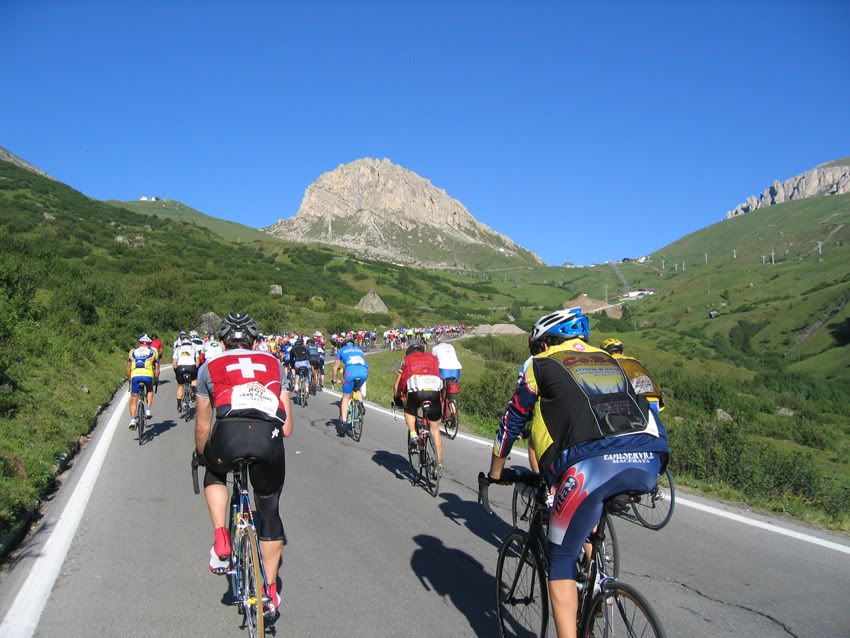
The official history of the Maratona dles Dolomitis states that it began in 1987, as a 175 km ride over seven mountain passes done by 166 cyclists to commemorate the tenth anniversary of the Società Ciclistica Alta Badia. One would assume that the majority, if not all of those cyclists were from the area of Alta Badia, or at the very least Italy. Things have certainly grown since then.
These days, there are over 8,500 cyclists who have traveled from all over the world to the Dolomites. In fact, this year there will be representatives from 35 countries, criss-crossing the globe, from Norway to New Zealand. It’s a virtual United Nations of Cycling. Perhaps to aid in the identification of the various nationalities while on the road, the Maratona prints your name on your number.
Obviously it’s not that difficult to spot the Italians, with their smoothly shorn, lovingly lubed, perfectly tanned legs, topped off by spotless kit, riding shiny and perfectly maintained Olmos, Pinarellos, Colnagos, Giants, and even Cannondales. If that’s not enough to go by, then names like Gianfranco, Giorgio, or Gianluca should do the trick. Otherwise, the easiest way to figure out who they are is the simple fact that they're the only ones talking and laughing.
While we all suffer in comparison to the Italians, the Germans probably suffer the most. You can usually spot them by the state of their kit, bought sometime around 1997, just after a certain German cyclist won the Tour de France. Otherwise, the grim look of determination, as they plod their way uphill on their Storck, Canyon, or Cube bikes with names like Dieter, Jurgen, and Rudolf on their backs, are clues that they support the Mannschaft.
The Dutch, bless their mysterious love of all things orange, aren’t much better. Granted, some of them will be on Koga-Miyatas or even a Batavus, and a few die-hards will be on Ger’s, but the rest will be on Colnagos and Treks. While most folk will think that the Dutch are Germans, the easiest way to tell the two apart is by the fact that the Dutch riders are at least 190cm tall. If that doesn’t help, then once again consult the names on their backs. Plenty will have a “van”, "van de", “van der”, or maybe even a “ten” between their first and last names. Don’t be confused, the rider ahead of you isn’t Joep De, it’s just Joep.
The Swiss, well, it’s difficult to tell who the Swiss are. That’s what they get for being neutral for so long. Also, you can’t really go by the names, because of the whole German, French, Italian thing. Fortunately for us, all Swiss riders are required to ride BMC bikes and wear the Assos Swiss national team kit. Make sure to say “hop schweiz” if you pass one of them.
The British are actually pretty easy to spot, thanks to their milky white calves. If that doesn’t help, then the slight look of being lost and confused by being amongst so many “foreigners” - who don’t even speak English - helps. If those tell take signs aren’t readily evident, then sometimes they make it easy for you by riding a Raleigh or a Dawes, and wearing a Union Jack, Wales, or Scotland jersey.
The Americans can easily be confused for the British if you judge them solely on their look of complete disorientation, except that the Americans look even more confused and far too serious, with a slight case of jetlag. A few obvious pointers are the Treks with the Project 1 paint jobs, the Stronglight Pulsion cranks, the Zero Gravity brakes, the Nokon cable housings, the Carpenter-Phinney Bike Camp jerseys, or the shorts that go down to their kneecaps.
I wonder if the 166 cyclists from 1987 realized what they were starting back in 1987? In the end it doesn’t really matter – when we ride the Maratona we’re all cyclists. There are no nationalities going up hill, just a procession of pain, done in silence, apart from the occasional shout of “occhio”.
Yes, the United Nations of Cycling, until you get to the top at least. Then it's downhill, where things are altogether different. That’s where it becomes very easy to spot the Dutch and the Germans: they’re the kamikazes who cut you off in the corner as they fly down the wet roads of the Pordoi.
You’ve been warned.



